If you asked a Commander player what the worst color in MTG was during the last few years, most would say white. Its lack of card draw and efficient mana ramp made it challenging to start on even footing with your opponents, making the setup of bigger plays in the late game needlessly difficult when compared to other colors.
While these were definitely problems that are being addressed in modern sets, I’ve been of the opinion for years that red is worse off than white ever was in Commander. Yes, you have some good acceleration and card filtering via gems like Dockside Extortionist and Faithless Looting, but there aren’t many other red cards like these.
Even if red had more strong draw and ramp options, power is unreliable when it isn’t tempered by consistency.
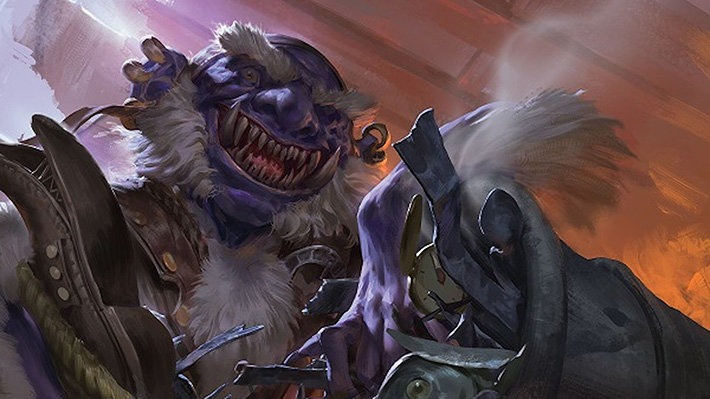
Don’t get me wrong – efficient card draw and mana acceleration are certainly important parts of a consistent deck, but nothing helps a deck’s reliability quite like a suite of tutors, or cards that let you search you deck for cards and add them to your hand or a more accessible zone like exile or the top of your library.
Unfortunately, generic tutor options are sorely lacking in red’s current selection of cards.
How Do Mono Red Tutors Work in MTG?
The vast majority of tutors in red (excluding intro deck tutors) focus on searching out specific types of creatures from your deck, then putting them either into your hand or the top of your library. While these range from good to incredible mileage in tribal builds focusing on one type of creature, red is more in Magic: The Gathering than Goblins or Dragons.
I’d even go so far as to say that it’s weird that red is so focused on creatures in its available tutors. For a color revolving around impulse and direct damage, creatures usually feel like a secondary focus in many respects when compared to card types like sorceries and instants. Yes, they’re important, but definitely not front and center.
All hope is not lost though – red does still have a few tutors that are designed with broader appeal in mind. There aren’t enough of them to say that they’re focused in any particular area, but this handful of cards definitely provides powerful ways to promote consistent performance across a lot of strategies.
As with other tutor articles, these selections are loosely ranked from worst to best, but are not intended as the be-all and end-all solution for every deck. Reviewing all your available options in Gatherer or Scryfall is always worthwhile when constructing or tuning a Commander deck, as you may find a gem that fits a niche need.
Minotaur Tutor – Deathbellow War Cry

Deathbellow War Cry has the potential to put Tooth and Nail to absolute shame – if Minotaurs weren’t so all over the place as a tribe. Despite their disorganized abilities, you can still do a lot of damage by putting 4 creatures onto the battlefield while saving a boatload of mana in the process.
Moraug, Fury of Akoum will almost always be one of your targets when resolving Deathbellow War Cry – the ability to snag an extra combat step while boosting your team will make up for a lot of raw power. Bonus points if you have a fetchland like Bloodstained Mire or something similar like Fabled Passage to score multiple extra combat phases.
From here, you have lots of good options to draw upon from the Minotaur card pool. Combine Moraug’s ability with Felhide Spiritbinder, snag haste and a power boost via Kragma Warcaller, generate a ton of mana with Neheb, the Eternal – you should have no problem shifting or solidifying the balance of power at the table if this spell resolves.
Top of Deck Tribal Tutors – Dwarven Recruiter, Flamekin Harbinger, Forerunner of the Empire, Giant Harbinger
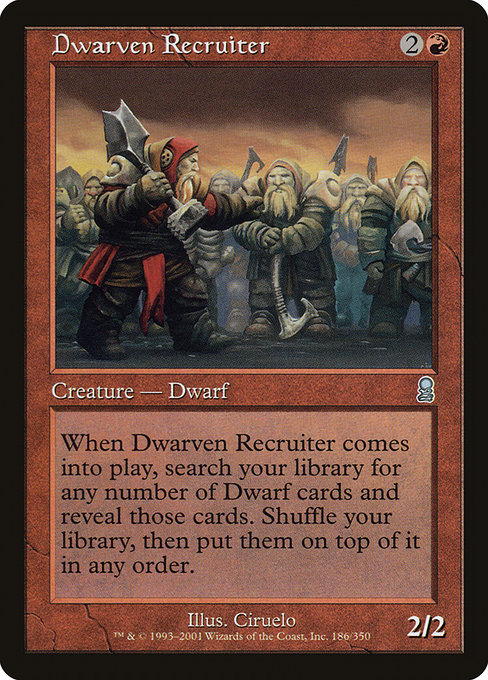
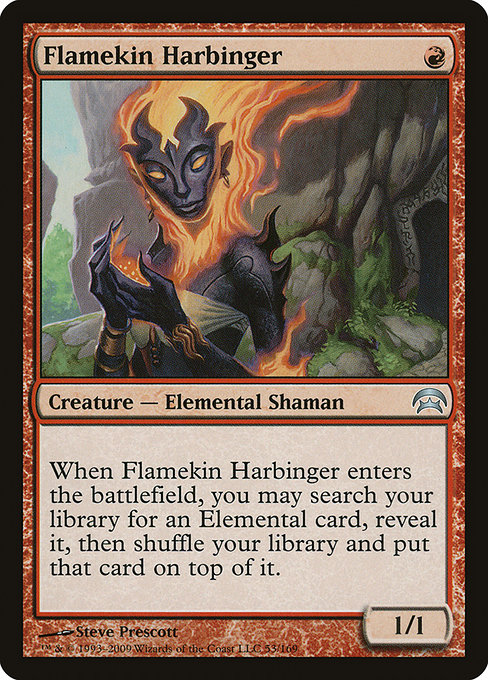


Tutors that place cards on top of my deck at sorcery speed generally aren’t my thing, but tribal decks that lack other tutor options will often gladly take any tutor they can get. While Lorwyn was noteworthy for printing so many of these Harbingers due to its tribal emphasis. this well is occasionally revisited for different tribes as with Forerunner of the Empire in Rivals of Ixalan.
Among these less used tribal tutors, however, Dwarven Recruiter has the strongest effect by far. Being able to search for any number of Dwarf creatures and stack them on top of your library is a recipe for future abuse when new Dwarves are printed – and people are more than happy to see if the newest dwarf is what finally breaks this powerful tutor every time one is released.
Dragon Tutors – Dragon’s Approach, Dragonstorm, Sarkhan’s Triumph, Zirilan of the Claw
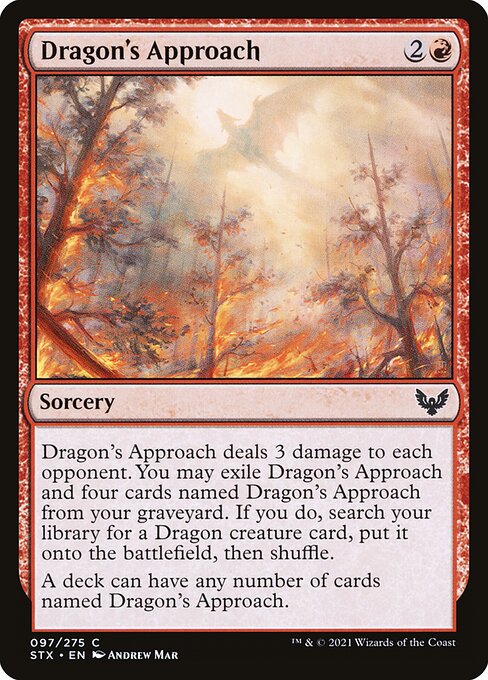
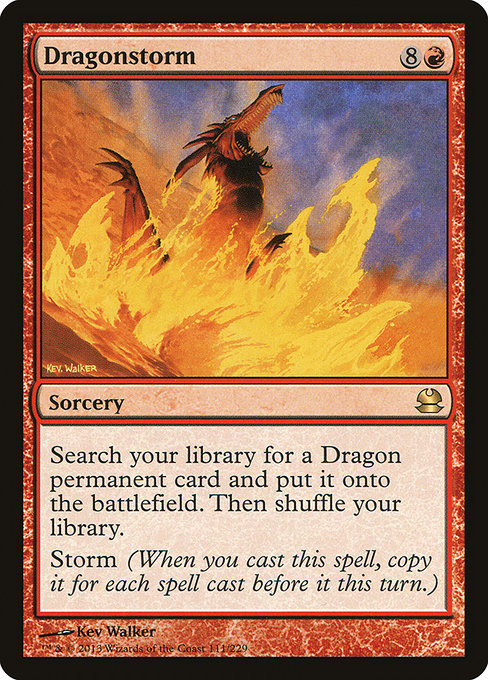
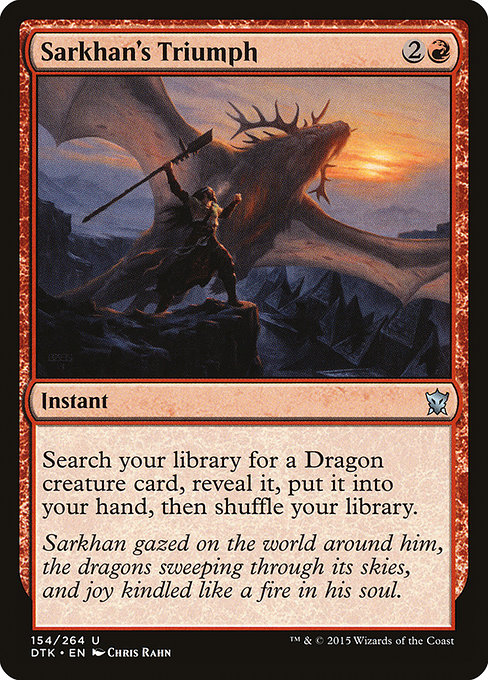
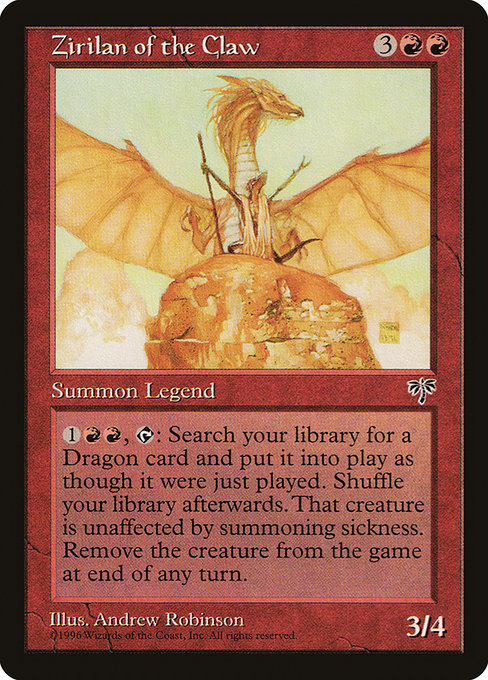
Dragons have been a popular tribal deck since Commander’s days as EDH (also know as Elder Dragon Highlander). This popularity isn’t exclusive to EDH in MTG’s history either – Dragonstorm was a popular constructed deck in multiple formats years ago, as putting four Bogardan Hellkites into play was alomost always a win for you on the spot.
Naturally, putting multiple more powerful dragons into play is well worth it if you can pull it off in Commander as well, but I generally only see 2-3 come out when most decks cast Dragonstorm. It’s just too slow when compared to the other options 5 color Ur-Dragon decks have for cheating creatures into play.
Zirilan of the Claw is similarly slow, as it needs to live through a turn cycle before it can use its effect. In a world where Sarkhan’s Triumph exists, it’s usually safer to tutor for the big dragon you want at the end of an opponent’s turn so you can cast it immediately after you untap for your turn. Plus it gets to stay in play instead of being exiled at turn’s end.
On the other hand, Zirilan can be your commander, so if you just want to be able to throw out powerful creatures from your deck at instant speed, you can still get a lot of mileage out of it as the head of a mono red dragon deck.
Regardless of how many colors your Dragon Commander deck has though, you’ll almost always have access to red, and therefore access to Dragon’s Approach. Play however many you want, bleed the table for 3 life each time you cast one, and get a free dragon for every 5th copy you use.
Seems pretty good, right?
And that’s before you start self-milling or using cards like Thrumming Stone to rush copies into your graveyard. Definitely worth trying if you get the chance to build the deck – it’s powerful and a ton of fun once you get going. Just be prepared to defend yourself once the table figures out what you’re doing.
Goblin Tutors – Goblin Matron, Goblin Recruiter, Moggcatcher
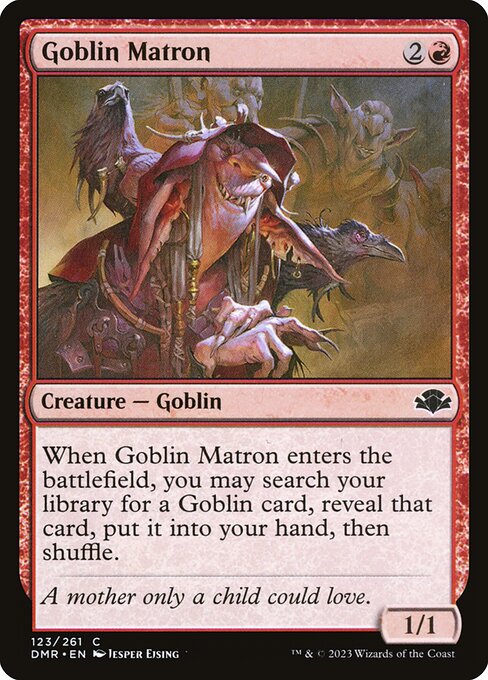
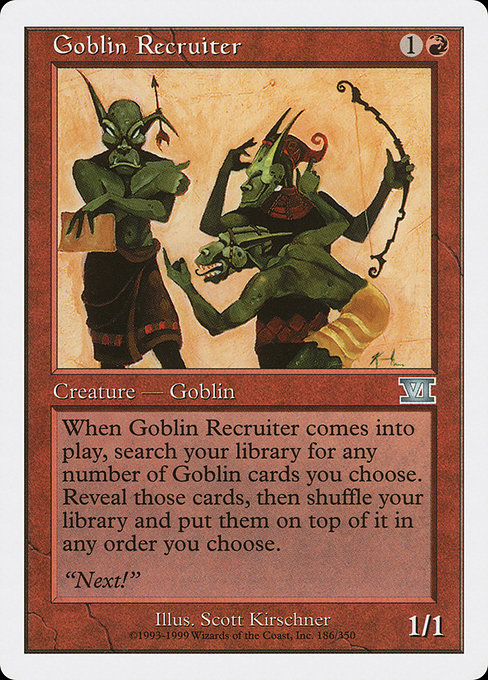
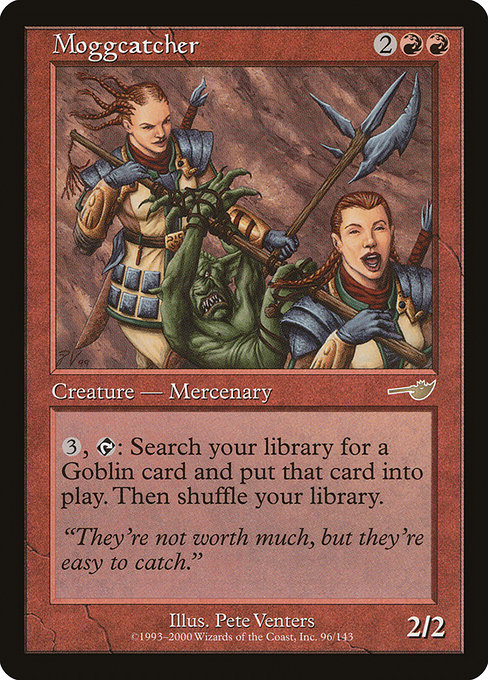
Goblins have been a force to be reckoned with in Commander for over a decade, traditionally headed by cards like Krenko, Mob Boss to make dangerous swarms or Purphoros, God of the Forge to inflict massive damage to the table in and out of combat, but plenty of other color combinations and strategies are quite viable too.
As one of Magic’s earliest creature types (dating back to Alpha), there have been a lot of opportunities to design support cards around Goblins over the years, but oddly, tutors for Goblins have primarily designed outside of blocks with a dedicated focus around the tribe like Onslaught and Lorwyn.
Goblin Recruiter is among the most dangerous tutors ever printed, as unlike Dwarven Recruiter, there are a ton of powerful ways to use it as a setup piece for explosive or game-ending plays.
Muxus, Goblin Grandee will simply let you put up to 6 of the creatures you search for onto the battlefield, allowing you to pump an existing horde with several lords, make a pile of tokens, snag a Dockside Extortionist for a mana boost, or refill your hand with a Goblin Ringleader.
If your deck has access to green, you can also pull some shenanigans with Food Chain, Conspicuous Snoop, and Squee, Goblin Immortal to make infinite mana and cast every creature in your deck. In fairness, Conspicuous Snoop enables a lot of infinite combos, but when paired with Goblin Recruiter, its potential becomes next level.
Goblin Matron is considerably more fair than the Recruiter, searching out any Goblin in your deck for 3 mana while leaving a 1/1 on the battlefield that can be buffed, used as a chump blocker, or enable a triggered ability. Very solid value that can serve as a stepping stone for many powerful plays immediately or on a later turn.
Moggcatcher is part of a cycle from Nemesis that is odd even among tutors – you pay mana (usually 3) to search for a creature of a specific type, put it into play, then shuffle your library. What makes this cycle so odd is that Moggcatcher, Seahunter, and Skyshroud Poacher don’t share the creature type they search out, while Lin Sivvi, Defiant Hero and Rathi Assassin do.
I get that Mercenaries and Rebels were big creature types for Mercadian Masques block, but it feels really jarring to put a creature into a tribal deck that doesn’t fit the tribe – even if it works well and has clear synergy with your game plan.
7 mana is a lot to ask for a tutor effect, regardless of what color you’re in, but the fact that Moggcatcher is repeatable is what makes it so potent. This is a creature you’ll want to remove on sight, as 2-3 activations can be all it takes to set up a combo or flood the board in a big way.
Magda, Brazen Outlaw

Magda, Brazen Outlaw got a lot of people brewing decks when it came out in Kaldheim, as people experimented with different combinations of Dwarves, Treasure enablers, and payoffs to see which combination was most consistent.
Many iterations proved modestly successful, but the cards that make Treasure tokens on their own proved to be more consistent than relying on Dwarves, so most people started trending in that direction with whatever powerful artifacts or Dragons they wanted to use to close the game.
This may not always remain the case though – Magda, Brazen Outlaw is the type of card that will only get better as more cards are printed over time, and with more Dwarves seeing print these days, it is entirely possible this balance of power could shift in favor of this under supported creature tribe.
Godo, Bandit Warlord

Godo, Bandit Warlord is best known for its ability to end games by itself in conjunction with Helm of the Host, to the point where even cEDH decks are built to revolve around this combo. This is a testament to how powerful tutors that place their targets on the battlefield truly are, as the savings from not having to cast the card you search for is often worth it, even when playing a 6 mana card.
Even if you aren’t planning to loop infinite combat phases, red has a lot of inherent support for artifacts that translates well to an equipment deck in addition to the tools it brings to the table for equipment cards themselves.
Mix in some powerhouses like Embercleave, Komainu Battle Armor, and The Reaver Cleaver in addition to your normal suite of powerful colorless equipment, and your opponents will dread what weapons Godo brings to your army each time he arrives on the battlefield.
Reckless Handling
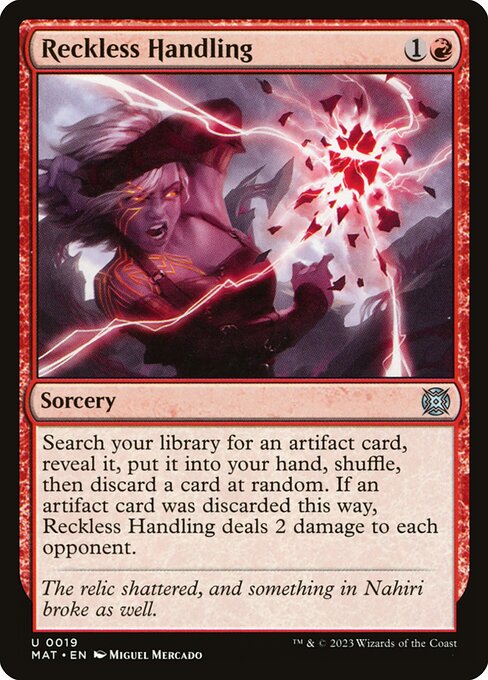
Sometimes, you need that early mana rock, late game bomb, or surprise combo piece, and you’re willing to do whatever it takes to try and get it into your hand, even if that means you might discard it in the process.
Heck, you might even be hoping for that outcome in some decks!
Reckless Handling may not be quite as cost-effective or consistent as later entries on this list, but I’ve found it to be an absolute godsend in artifact decks looking for that extra source of consistency. It can blow up in your face, but more often that not, you can sculpt your hand to achieve either the result you want or an acceptable loss.
And if you are unlucky enough to discard what you tutored for, at least you get the petty satisfaction of doing 2 damage to all your opponents as a consolation prize.
Goblin Engineer
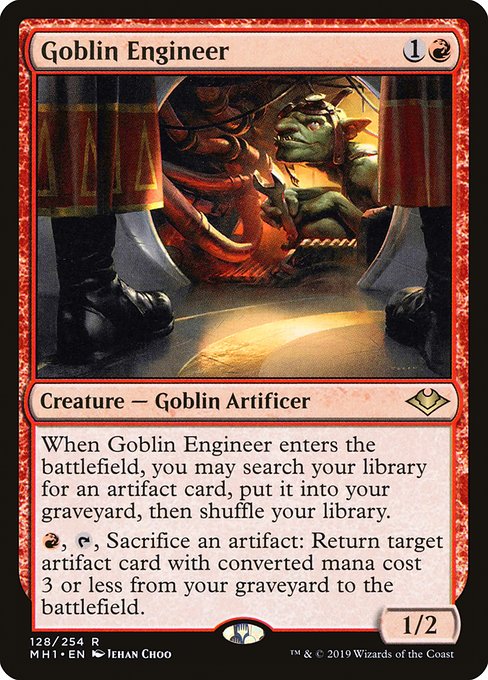
Cards like Unmarked Grave and Goblin Engineer didn’t get a lot of fanfare during the release of their respective Modern Horizons sets, as they were considered slower, restricted versions of Entomb, but while it’s easy for a card to get lost among the tutor effects black offers, the fact that Goblin Engineer is red makes all the difference in the world.
Being able to put any artifact in the graveyard from your deck simply for having this card enter the battlefield is an incredible setup for reanimation effects like Trash for Treasure, Daretti, Scrap Savant, and Goblin Welder, allowing you to trade something like a mana rock for a powerhouse like Darksteel Forge with ease.
Of course, if you’re looking for something that costs 3 mana or less, you don’t actually need any of these other cards – Goblin Engineer has the same type of effect built right in! While not as flashy as the other examples, there are plenty of artifacts with enter the battlefield or leave the battlefield effects that you can abuse.
If that isn’t your cup of tea, trading less useful artifacts or those that will be lost at the end of your turn for previously destroyed or discarded mana rocks, equipment, and utility artifacts can have an impact on the game that is far larger than it looks at first glance. Definitely worth your time in many artifact and reanimator builds.
Imperial Recruiter
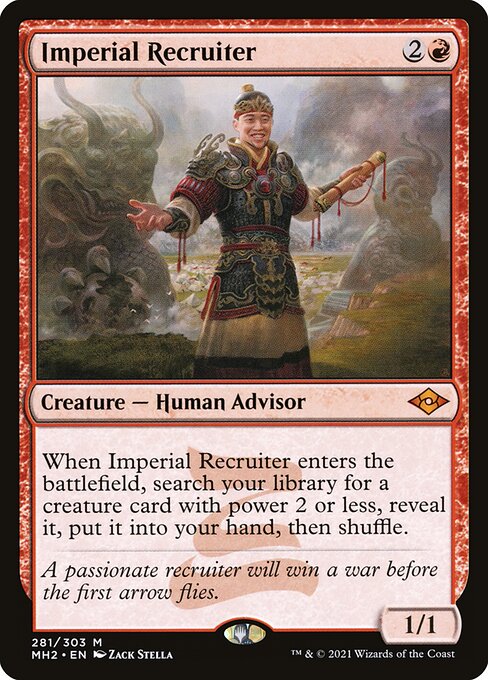
One of red’s best tutors was also its rarest for a long time, so I’m beyond glad that Imperial Recruiter is finally getting the reprints it was long overdue for. Originally released in Portal Three Kingdoms, it took nearly 20 years for it to become widely accessible in Masters 25, and you can get copies now for just a few dollars thanks to the additional printings it has had since.
While 2 power may not present a particularly impressive offense, creatures have gotten considerably more powerful effects since 1999, offering everything from spot removal (Aether Channeler, Duergar Hedge-Mage) to utility (Anger, Dire Fleet Daredevil, various Clones) to infinite combo pieces (Kiki-Jiki, Mirror Breaker, Walking Ballista).
With access to all of these possibilities at your fingertips for a mere 3 mana creature, Imperial Recruiter is a borderline staple for most decks that can play it – even if they have access to colors with better tutors. And if you get to double up with a Panharmonicon or Elesh Norn, Mother of Machines, that’s just good clean living.
Gamble

As someone who prefers to make plays that offer guaranteed results in a vacuum, it took me a very long time to appreciate what Gamble has to offer as a tutor. Don’t get me wrong – the ability to put any card into your hand for 1 red mana is unparalleled among tutors, but the random discard is a major turn off at face value.
But trust me, it’s worth the risk in almost any deck. Even dedicated combo builds. Maybe even especially those.
Most consistent decks in Commander aim to build with a degree of consistency. Tutors play a crucial role in that, as do cards with different names, yet similar effects. But another key part of consistency in Commander is recursion.
Your graveyard is a resource much like your mana or life total, so if you can play efficient cards that let you pull or replay cards in your graveyard, Gamble‘s downside is irrelevant during those unlucky moments where you discard what you searched for, as all you’ve done is turn your Demonic Tutor into Entomb.
If you have other cards in your hand you care about, however, learning how to time your Gamble is critical for success. Drawing a line between what you need to win the game versus what is convenient in the moment will help you prioritize what needs to be played before you cast this tutor.
Even then, the answer might be to accumulate a large hand to improve your odds before playing Gamble and hoping for the best. You might still lose to the odds with this capricious effect, despite your best preparations, but if you succeed more often than you fail, you’ve either developed a good understanding of when to play this card or an abundance of good fortune.
Both good things to bring to a Commander pod in any case, so put in some practice time and see what the most cost-effective tutor in MTG can do for you. And don’t be duped into playing its cousin Fervent Mastery – this is a case where stapling multiple copies of the same effect is more hindrance than help outside of reanimator decks.
Are Red Tutor Spells Good in MTG?
Compared to most other colors in MTG, no. In a vacuum, however, the answer depends. Red’s tribal tutors are usually quite good in creature decks that revolve around a specific creature type. Tutors that work with artifacts are also going to be decent in artifact builds, even if they frequently make you jump through hoops to use them.
Imperial Recruiter and Gamble offer the broadest appeal as tutors in red’s entire pool of cards, and both are absolutely incredible. Arguments could even be made for Gamble being the best tutor in the game, though the random discard usually shifts that honor toward Demonic Tutor.
Play both where you can, and lean on other colors to fill out your tutor count from there.
Other MTG Articles You Might Enjoy
- MTG Blue Tutor Cards for Commander
- MTG Black Tutors for Commander
- Mono Red Ramp for Commander
- Red Board Wipes for Commander
- MTG Colorless Board Wipes for EDH
- EDH Reanimator Commanders
Braden is a founder of Assorted Meeples and has been a gamer & writer with a vivid imagination all his life. Don’t believe us? Check out his excitement when meeting Goosebumps author R.L. Stine as a kid! An avid Magic: The Gathering spellslinger for over 15 years, you can always convince him to shuffle up for a game (or three!) of Commander.
